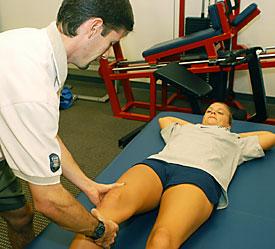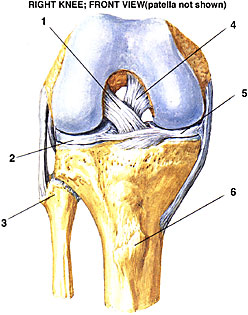 |
|
KEVIN KLAUS/Arizona Daily Wildcat
|
Associate athletic trainer Matt Radelet performs the Lockman's test for ACL stability on junior gymnast Amanda Goins. The test measures the amount of movement in the knee joint and can detect damage to the ACL.
|
|
By Jeff Lund
Arizona Daily Wildcat
Thursday September 26, 2002
Athletes learn about their ligaments the painful way
The ACL. Known to most of us as part of the knee, to athletes as the difference between playing and sitting on the bench, and to the medical world as the anterior cruciate ligament.
Intact, the ACL provides athletes with the ability to perform at optimum levels, but in the blink of an eye, can bring a temporary or permanent stoppage to one's playing days.
Sophomore cornerback Michael Jolivette received an anatomy lesson about his ACL following an injury on the last day of practice before the game at Wisconsin last week.
Though Jolivette's injury will keep him out for a couple of months, he should consider himself very lucky since he did not suffer a partial or complete tear.
"The receiver was trying to jump over me," Jolivette said describing his injury. "I deflected the pass, and as I went down, my leg was behind me and his whole body came down on my knee."
Within seconds, Jolivette knew something was wrong and feared the worst.
"I heard a pop but I didn't know if it was my knee or my hip," Jolivette said. "I was in an awkward position. I was scared. I knew instantly that something was wrong when I rolled over. My knee didn't look right."
Once theACL is damaged, medical attention is necessary, said Arizona associate athletic trainer Matt Radelet.
"Typically, the tear occurs when a force is applied to the knee from the outside moving in," Radelet said. "Like when the athlete has a planted foot and rotates the opposite direction. That is the most typical mechanism for an ACL tear."
Radelet said that in different sports, the knee is put in various positions that create circumstances in which the ACL can be torn.
"In basketball jump stops are a frequent way ACL's are torn," Radelet said. "When the athlete hits the floor and stops quickly, the quadriceps muscle pulls on the tibia. That is what the ACL is for ¸ to prevent movement in a forward motion. If the force is stronger than the ACL, the ACL tears."
Senior women's basketball player Krista Warren knows all about this situation, but she was not as fortunate as Jolivette.
During her sophomore season in a game at Oregon, the 6-foot-2 forward made a move she will never forget.
"It was the beginning of the second half," Warren said. "I got the ball on the wing, drove to the middle, did a jump stop to shoot and I felt it pop. I couldn't feel anything after that. It just went numb."
Unlike some other athletes who injure their knees, Warren said she knew from the start that her ACL tore.
"Pretty much everyone in my family has torn their ACLs," Warren said. "I guess I just had to go along with the tradition."
After she was taken to the locker room, the official diagnosis was easy.
"When I went down in the locker room (the doctor) just looked at it, touched it and said ╬yeah, it's gone,'" Warren said. "We didn't even need an MRI."
Though Warren's ACL was badly torn, she did escape what is know as the "unhappy triad" ÷÷ the simultaneous tearing of the ACL, medial collateral ligament and the meniscus.
 |
|
Courtesy Arizona Athletic Department
Structure of the right knee with the kneecap not shown.
1. Anterior Cruciate Ligament
2. Lateral Meniscus
3. Fibula
4. Posterior Cruciate Ligament
5. Medial Meniscus
6. Tibia
|
|
Diagnosis
Though Warren's case was a simple diagnosis, Radelet said that there are a few steps to take for proper diagnosis.
"Clinically, we use a couple different tests. One is the drawer test and the other is the Lockman's," he said. "They just measure how far the shinbone will move forward. That is the direction the ACL is designed to prevent. You compare the two knees and if you get a lot more movement in that direction, then you get suspicious."
In Jolivette's case, the initial thought was for the worst, and the sophomore cornerback worried he would not see action for the rest of the season.
"I was really worried because I heard people saying, ╬If it's your ACL, just don't worry; you will have to have surgery and sit out this season,'" Jolivette said. "That's all that was going through my head. I was thinking about what I lost, the season. Once I figured I didn't need surgery, I felt better."
Radelet said the next step is to move on to the MRI to see if, in fact, the ACL is torn. Thanks to advancements in today's medical world, recovering from an ACL injury is common, Radelet said.
"Even as late as the late '70s (a torn ACL) was considered a career-ending injury," Radelet said. "Now there are plenty of examples of athletes that have had this injury and surgery and are back within six months. As things improve in the operating room and in rehab, we are getting them back a lot quicker."
Treatment
Following her memorable jump stop in Oregon, Warren continued to work out lightly, trying to strengthen her knee before surgery.
"After the first two or three weeks, it was a bit shaky; but after that I felt like I could play," Warren said.
Typically, what happens following an ACL tear is that the other muscles, ligaments and tendons work over time to keep the knee in place and working correctly, giving the athlete a false feeling of security.
Despite her confidence in her knee, Warren went under the knife.
Radelet said there are a few procedures common to repairing a torn ACL.
"There are a few options," Radelet said. "The most common involves taking a piece of the patella tendon and using that to replace the ligament. A new method that is becoming more popular is using a piece of the hamstring."
"They took from my patella," Warren said. "Then they put some bolts and stuff in and just remade my knee. I thought I would have problems with metal detectors (at airports) but I don't."
Other options include using ligaments from a cadaver or synthetic materials, Radelet added.
Recovery
"Rehab was good," Warren said. "Every once in a while, I get scar tissue in there that pops and it hurts, but I am fine now."
Almost two years removed from her surgery and with a full season under her belt following the tear, Warren said she still worries a bit about her knees.
"I would say I am more worried about my other knee than the hurt one," Warren said. "This one feels much stronger now that it is fixed."
"The biggest thing is continuity in rehab process and adhering to the rehab process," Radelet said. "We are fortunate we can see that athlete every day. In the general public, depending on insurance, they can only get 12 visits total to a physical therapy clinic."
Jolivette, relieved by the prognosis, knows how lucky he is and is eager to get back in uniform.
"I have it real good," Jolivette said. "I can bounce back."

